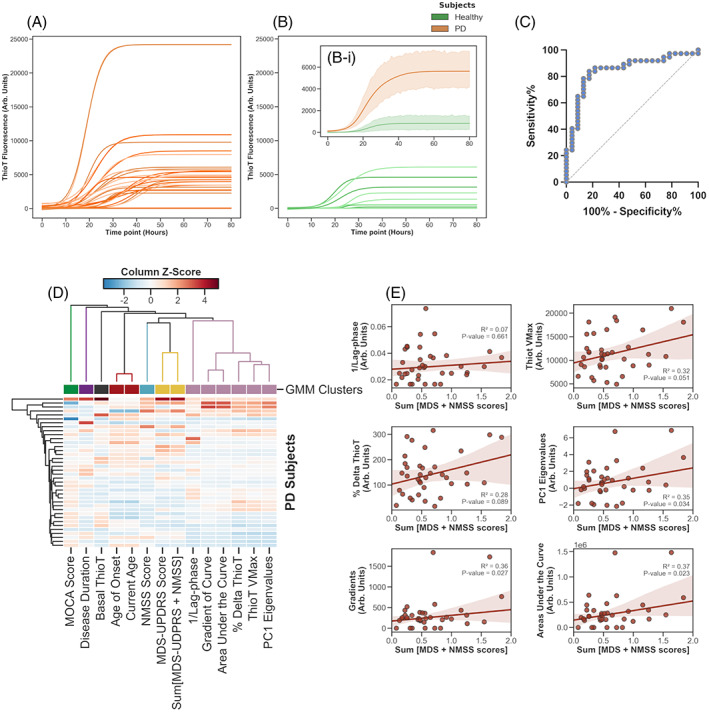FIG 1.

Logistic growth curves fitted to the raw kinetic curve data obtained from RT‐QuIC reactions seeded with the saliva of 37 PD patients (A) (orange lines) and 23 healthy subjects (B) (green lines). The average kinetic curves for the PD and HS subject groups are shown in (Bi); error bands represent standard deviation from the mean. Row data used to generate growth curves have been corrected for individual baseline values to eliminate the background. ThT fluorescence threshold normalized for baseline has been fixed at 2990.5 relative fluorescence units (RFU). (C) ROC analysis of PC1 Eigenvalues for all subjects: sensitivity of 83.78% (95% CI, 68.86–92.35), specificity of 82.61% (95% CI, 62.86–93.02), and a likelihood ratio of 4.818 and AUC = 0.8437. (D) A heatmap of PD subject data, which identified 7 nominal clusters, with the RT‐QuIC parameters forming one cluster (light purple) and the clinical parameters (yellow and turquoise) forming other two closely associated clusters. Agglomerative hierarchical clustering demonstrates that the RT‐QuIC parameters cluster (light purple) is hierarchically closer to the clinical scores clusters (yellow and turquoise), and more distant to other clusters: age/age of onset (red), disease duration (purple) and MoCA score (green), as well as basal Thio‐T (dark‐grey). (E ) Linear regression performed between RT‐QuIC kinetic parameters and the summed MDS‐UPDRS and NMSS scores. Pearson's correlation test found statistically significant correlations with three RT‐QuIC parameters: PC1 Eigenvalues (P = 0.034, r 2 = 0.35); gradients of fitted curves (P = 0.027, r 2 = 0.36); and areas under fitted curves (P = 0.023, r 2 = 0.37). RT‐QuIC, real‐time quaking induced conversion; PD, Parkinson's disease; ThT, Thioflavin‐T; ROC, receiver operating characteristic; CI, confidence interval; AUC, area under the curve; MoCA, Montreal Cognitive Assessment; MDS‐UPDRS, The Movement Disorder Society‐Sponsored Revision of the Unified Parkinson's Disease Rating Scale; NMSS, The Non Motor Symptoms Score.
